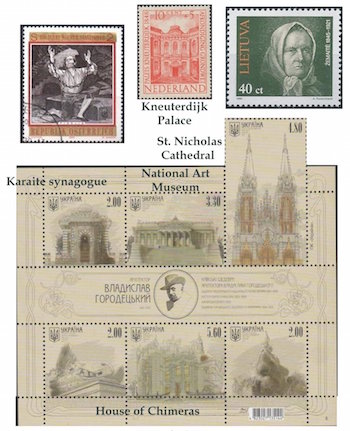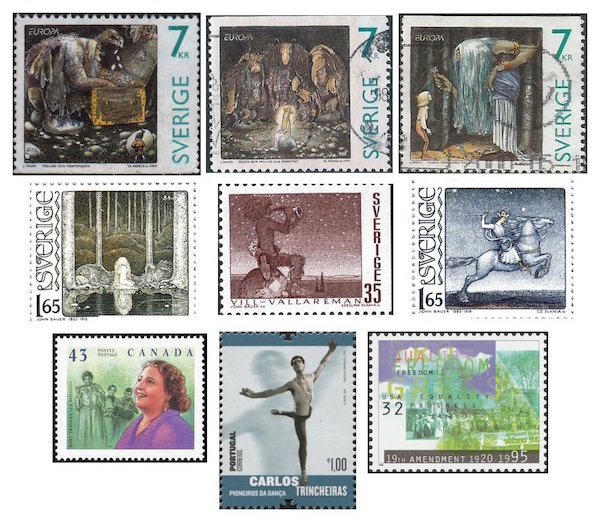The Arts on the Stamps of the World — June 4
An Arts Fuse regular feature: the arts on stamps of the world.

By Doug Briscoe
I mentioned in yesterday’s piece that Jan Peerce was deserving of a stamp. Today is the centenary of another worthy opera singer, baritone Robert Merrill (June 4, 1917 – October 23, 2004), but he, too, remains stampless.
So perhaps there is a certain irony in that today’s best known figure, probably, is also an operatic star, tenor Anton Dermota. Shown here as Florestan in Beethoven’s Fidelio, he was born on this date in 1904 in Slovenia (then part of the Austro-Hungarian Empire). This is another stamp from the sheet issued in 1969 for the centenary of the Vienna State Opera, where Dermota was a member of the company for over forty years. He first appeared there in 1936, having been “discovered” by Bruno Walter. The building was destroyed by an Allied air raid in 1945, and Dermota played Florestan when the house reopened ten years later. He also sang frequently at the Salzburg Festival, first in Die Meistersinger under Toscanini in 1937. He was, however, most associated with the operas of Mozart. Anton Dermota died in Vienna on June 22, 1989.
Born in Paris in 1661, French architect and engraver Daniel Marot died on this date in 1752. Marot learned his craft from his father. As a Protestant Huguenot he fled France after the Revocation of the Edict of Nantes (1685) and took up residence in Holland. There he was employed by the future William III of England, designing interiors for Het Loo Palace. William became king, Marot accompanied him to London and was named Master of Works. His particular focus was on Hampton Court Palace, where he designed garden parterres, furniture, mirrors, beds, etc. Marot returned to the Netherlands after the king’s death and built Kneuterdijk Palace in The Hague in 1716, which edifice is seen on the Dutch stamp of 1948.
The Lithuanian/Samogitian writer Julija Beniuševičiūtė-Žymantienė was born on this date (4 June [O.S. 23 May]) in 1845 to down-and-out Lithuanian gentry, but was forbidden to associate with local children or learn the Lithuanian language—which at the time was felt to be socially déclassé (Polish was all the rage). She learned it anyway (she was basically an autodidact) and would go on to develop into one of the central figures in the Lithuanian National Revival as a writer of realist fiction that focused on peasant life. Her early years, though, were largely devoted to farming and family; it was only through the encouragement of the writer and journalist Povilas Višinskis and the linguist Jonas Jablonskis in the 1890s that she began publishing her work. She adopted the pen name of Žemaitė. Eventually she moved to Vilnius as an administrator and editor of various publications, then, during World War I, to Russia and the United States, returning to Lithuania in the year of her death, 1921 (7 December). Her 150 works, typically rather dark in tone, deal with the basic matters of poverty, family life, and the beauty of nature.

Another figure from this same milieu was Władysław Horodecki (Russian Vladislav Gorodetsky; June 4 [O.S. May 23] 1863 – January 3, 1930), an architect who was also born into a noble family, albeit in his case a Polish one living in Ukraine. He studied in Moscow and erected many striking buildings in Kiev, including the National Art Museum of Ukraine (1898), the Karaite synagogue (1898-1902; since 1981 the Ukrainian House of Actors), the House with Chimeras (1901-02), and St. Nicholas Roman Catholic Cathedral (1909). All of these are shown on stamps on an Ukrainian souvenir sheet from 2014. I’ve modified the image to avoid duplication. On Polish independence Horodecki emigrated to Warsaw in 1920, then in 1928 was invited to Tehran, where he designed the Tehran railway station. He died and was buried in that city. In 1996 a street in Kiev was renamed for him.
Painter and muralist John Bauer (4 June 1882 – 20 November 1918) is remembered on stamps more as an illustrator whose works evoked the mythology and folk legend of his native Sweden. This work is most famously represented in the annual publication Among Gnomes and Trolls, begun in 1907 (it still exists today). Bauer was self-deprecating about this work and aspired to a reputation as a painter of oils and frescoes. One of his paintings, Still, Tuvstarr sits and gazes down into the water (1913, second row left), is so well known in Sweden that its use in advertisements has caused something of a stir regarding the proper use of art for such purposes. Bauer died with his wife and two-year-old son when a steamer, overloaded with cargo, foundered, claiming the lives of all 24 people on board.
Today is also the birthday of French Canadian folksinger Mary Bolduc (1894 – February 20, 1941), known as Madame Bolduc or La Bolduc. She and her seven siblings grew up bilingual in Quebec. She married in Montreal and returned there after a brief spell in Springfield, Massachusetts. Her musical career started as a folk fiddler with Conrad Gauthier’s troupe in 1928. She started making recordings the next year and, after an initial flop, had a huge hit, after which her success was assured. As the result of a serious automobile accident in 1938 La Bolduc learned she had cancer, of which she expired at age 46.

Portuguese ballet dancer and choreographer Carlos Trincheiras (1937 – 13 May 1993) was a founder of and first dancer for the Gulbenkian Ballet. He choreographed more than thirty pieces for this and other ballet companies, for television and film. Trincheiras was artistic director of the Teatro Guaíra Ballet , from 1979 to his death in 1993. He married to ballerina Isabel Santa Rosa, who was also represented in this same set of stamps from 2015.
Since our offerings are rather scanty today, I thought I’d flesh out this piece with a couple of other anniversary notices. On this day in 1912 Massachusetts became the first state to set a minimum wage. In 1917, the first Pulitzer Prizes were awarded, but none for fiction, poetry, or music that year. In 1913 a suffragette named Emily Davison was mortally injured when she ran in front of King George V’s horse at the Epsom Derby; six years later to the day, the U.S. Congress approved the 19th Amendment to the Constitution, guaranteeing suffrage to women.
A graduate of the University of Massachusetts with a B.A. in English, Doug Briscoe worked in Boston classical music radio, at WCRB, WGBH, and WBUR, for about 25 years, beginning in 1977. He has the curious distinction of having succeeded Robert J. Lurtsema twice, first as host of WGBH’s weekday morning classical music program in 1993, then as host of the weekend program when Robert J.’s health failed in 2000. Doug also wrote liner notes for several of the late Gunther Schuller’s GM Recordings releases as well as program notes for the Boston Classical Orchestra. For the past few years he’s been posting a Facebook “blog” of classical music on stamps of the world, which has now been expanded to encompass all the arts for The Arts Fuse.
